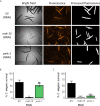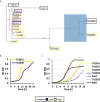Development and Characterization of High-Throughput Caenorhabditis elegans - Enterococcus faecium Infection Model
- PMID: 33996637
- PMCID: PMC8116795
- DOI: 10.3389/fcimb.2021.667327
Development and Characterization of High-Throughput Caenorhabditis elegans - Enterococcus faecium Infection Model
Abstract
The genus Enterococcus includes two Gram-positive pathogens of particular clinical relevance: E. faecalis and E. faecium. Infections with each of these pathogens are becoming more frequent, particularly in the case of hospital-acquired infections. Like most other bacterial species of clinical importance, antimicrobial resistance (and, specifically, multi-drug resistance) is an increasing threat, with both species considered to be of particular importance by the World Health Organization and the US Centers for Disease Control. The threat of antimicrobial resistance is exacerbated by the staggering difference in the speeds of development for the discovery and development of the antimicrobials versus resistance mechanisms. In the search for alternative strategies, modulation of host-pathogen interactions in general, and virulence inhibition in particular, have drawn substantial attention. Unfortunately, these approaches require a fairly comprehensive understanding of virulence determinants. This requirement is complicated by the fact that enterococcal infection models generally require vertebrates, making them slow, expensive, and ethically problematic, particularly when considering the thousands of animals that would be needed for the early stages of experimentation. To address this problem, we developed the first high-throughput C. elegans-E. faecium infection model involving host death. Importantly, this model recapitulates many key aspects of murine peritonitis models, including utilizing similar virulence determinants. Additionally, host death is independent of peroxide production, unlike other E. faecium-C. elegans virulence models, which allows the assessment of other virulence factors. Using this system, we analyzed a panel of lab strains with deletions of targeted virulence factors. Although removal of certain virulence factors (e.g., Δfms15) was sufficient to affect virulence, multiple deletions were generally required to affect pathogenesis, suggesting that host-pathogen interactions are multifactorial. These data were corroborated by genomic analysis of selected isolates with high and low levels of virulence. We anticipate that this platform will be useful for identifying new treatments for E. faecium infection.
Keywords: C. elegans; E. faecium; high-throughput screen; host-pathogen interaction; virulence.
Copyright © 2021 Revtovich, Tjahjono, Singh, Hanson, Murray and Kirienko.
Conflict of interest statement
The authors declare that the research was conducted in the absence of any commercial or financial relationships that could be construed as a potential conflict of interest.
Figures









Similar articles
-
[Investigation of Antibiotic Resistance and Virulence Factors of Enterococcus faecium and Enterococcus faecalis Strains Isolated from Clinical Samples].Mikrobiyol Bul. 2020 Jan;54(1):26-39. doi: 10.5578/mb.68810. Mikrobiyol Bul. 2020. PMID: 32050876 Turkish.
-
Typing of Enterococcus spp. strains in 4 hospitals in the Małopolska region in Poland.Adv Clin Exp Med. 2018 Jan;27(1):111-117. doi: 10.17219/acem/68265. Adv Clin Exp Med. 2018. PMID: 29521051
-
Both live and dead Enterococci activate Caenorhabditis elegans host defense via immune and stress pathways.Virulence. 2018 Dec 31;9(1):683-699. doi: 10.1080/21505594.2018.1438025. Virulence. 2018. PMID: 29436902 Free PMC article.
-
Evolution of virulence in Enterococcus faecium, a hospital-adapted opportunistic pathogen.Curr Opin Microbiol. 2018 Feb;41:76-82. doi: 10.1016/j.mib.2017.11.030. Epub 2017 Dec 9. Curr Opin Microbiol. 2018. PMID: 29227922 Review.
-
Model systems for the study of Enterococcal colonization and infection.Virulence. 2017 Nov 17;8(8):1525-1562. doi: 10.1080/21505594.2017.1279766. Epub 2017 May 4. Virulence. 2017. PMID: 28102784 Free PMC article. Review.
Cited by
-
Gut microbiome dynamics and predictive value in hospitalized COVID-19 patients: a comparative analysis of shallow and deep shotgun sequencing.Front Microbiol. 2024 Jun 19;15:1342749. doi: 10.3389/fmicb.2024.1342749. eCollection 2024. Front Microbiol. 2024. PMID: 38962119 Free PMC article.
-
The population structure of vancomycin-resistant and -susceptible Enterococcus faecium in a low-prevalence antimicrobial resistance setting is highly influenced by circulating global hospital-associated clones.Microb Genom. 2023 Dec;9(12):001160. doi: 10.1099/mgen.0.001160. Microb Genom. 2023. PMID: 38112685 Free PMC article.
-
Epidemiological profiles and pathogenicity of Vancomycin-resistant Enterococcus faecium clinical isolates in Taiwan.PeerJ. 2023 Feb 23;11:e14859. doi: 10.7717/peerj.14859. eCollection 2023. PeerJ. 2023. PMID: 36855433 Free PMC article.
-
Genome Analysis of an Enterococcal Prophage, Entfac.MY.Avicenna J Med Biotechnol. 2022 Jul-Sep;14(3):196-205. doi: 10.18502/ajmb.v14i3.9826. Avicenna J Med Biotechnol. 2022. PMID: 36061127 Free PMC article.
-
Pathogen-induced dormancy in liquid limits gastrointestinal colonization of Caenorhabditis elegans.Virulence. 2023 Dec;14(1):2204004. doi: 10.1080/21505594.2023.2204004. Virulence. 2023. PMID: 37096826 Free PMC article.
References
Publication types
MeSH terms
Substances
Grants and funding
LinkOut - more resources
Full Text Sources
Other Literature Sources
Miscellaneous

